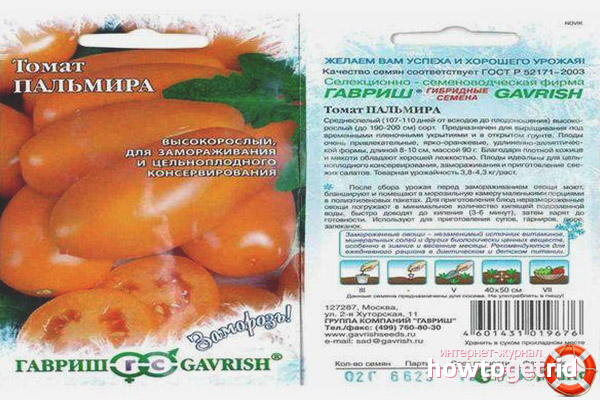The content of the article
There are many varieties of tomatoes so that they grow and delight with delicious tomatoes, they need to be looked after. Everyone needs care, so you need to pay attention to plants. Only some can be planted and spend a little time on them (which is good for gardeners without experience and experience), while others require constant care and supervision. They should be watched and performed many actions - to tie up, form bushes, constantly feed. But the reward for these works is decent and joyful - a large crop of delicious, long-stored tomatoes, suitable for salads and for long-term storage. It is a tomato called Palmyra.
Description
Bushes
Palmyra is an indeterminate type of tomato suitable for growing everywhere - both in open ground and in greenhouse conditions. Bushes reach large sizes: planted on the street grow up to 2 meters, planted in a greenhouse - even higher by 20-30 centimeters. Such large sizes make it clear that the plant must be tied up. Otherwise, the bush will break under the load of berries or fall to the ground under a gust of wind, causing the crop to die.
A lot of extra branches grow on the bush, inhibiting the development of tomatoes and requiring removal. That is - the formation of a bush is necessary. As a rule, you must remove all stepsons and leave only the main trunks.
Fruit
The shape of the berries in this variety is unusual - the fruits are oblong and slightly elongated, resembling peppers, each about 9-10 centimeters long. Feature - a ledge at the end of the fetus, the so-called "nose". The color is lemon orange. The skin is quite thick and strong, which allows you to transport vegetables at any distance without harm to them. The taste is very pleasant, slightly sweet, in the pulp a lot of juice.
Suitable for canning in all forms, suitable for freezing. Also, these tomatoes can be dried - in this case, they will retain all the nutrients that will be very useful in winter.
Seedlings
As soon as two leaves appear on the sprouts, they need to be dived - this will make the seedlings stronger. It is necessary to conduct hardening - take the containers with Palmyra outside for two weeks, lengthening the time spent in the fresh air daily. This will help tomatoes to adapt to natural conditions, they will become stronger and more resilient.
After the appearance of the 6th or 7th leaf and at least one flowering branch, bushes are planted in the ground.
Care
Seedlings are planted in 3-4 pieces per square meter. Considering that each bush gives about 5 kilograms of berries, we can assume that this is a lot. But without top dressing and constant watering, there will be no crop. It should be fed at least twice - when flowering occurs and during ripening. Better often. Fertilizing can be used in different ways - buy mineral with phosphates and potassium or use organic (ash, manure, compost).
Drop watering is recommended - you need to spray the plants 4-5 times a week, and in the heat every day. In the absence of such an opportunity, ordinary watering can also be used. It is recommended to carry out this procedure after sunset, when the heat subsides, so as not to damage the roots. Careful hilling and weeding will increase the chances of a large crop many times over.
Diseases
This variety has a very high immunity to diseases affecting tomatoes. But, just in case, you need to look to see if the bush has changed the look for the worse. If deviations become noticeable, measures should be taken immediately.
How are the fruits applied?
Palmyra is a versatile vegetable. It can be used as you like:
- Eat directly from the bush, use in salads and other dishes.
- Preserve for the winter.
- Process, make juices, all kinds of sauces and ketchups.
- Dry, freeze and dry.
Reviews
Ivan P., 36 years old: Palmira advised friends. They said it was very productive. Planted seedlings on February 3, in May, planted in a greenhouse. Bushes grew tall, had to put props. The variety is capricious, requires a lot of attention and labor - constantly need to thin out bushes, weed and loosen. But the harvest was immensely pleased. 6-7 brushes with long yellow tomatoes grow on a bush. And so they ate, and did salads, and salted a lot. The banks look beautiful, but the taste is even better.
Video: Palmyra tomatoes











Submit